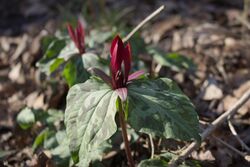Biology:Trillium maculatum
| Trillium maculatum | |
|---|---|

| |
| Scientific classification | |
| Kingdom: | Plantae |
| Clade: | Tracheophytes |
| Clade: | Angiosperms |
| Clade: | Monocots |
| Order: | Liliales |
| Family: | Melanthiaceae |
| Genus: | Trillium |
| Species: | T. maculatum
|
| Binomial name | |
| Trillium maculatum Raf.[2]
| |
| Synonyms[3] | |
|
Trillium maculatum
| |
Trillium maculatum, the spotted wakerobin or spotted trillium,[4][5] is a species of flowering plant in the family Melanthiaceae. It is a member of the Trillium cuneatum complex, a closely related group of sessile-flowered trilliums. The species is endemic to the southeastern United States, ranging across Alabama, Georgia, South Carolina, and northern Florida.
Description
Trillium maculatum is a perennial, herbaceous, flowering plant that persists by means of an underground rhizome. Like all trilliums, it has a whorl of three bracts (leaves) and a single trimerous flower with three sepals, three petals, two whorls of three stamens each, and three carpels (fused into a single ovary with three stigmas).[6] It has a sessile flower (no flower stalk), erect petals, and mottled leaves.[7] Its flower petals are deep red or reddish-purple but occasionally yellow.[5]
Taxonomy
Trillium maculatum was first described by Constantine Samuel Rafinesque in 1830.[2] The specific epithet maculatum means "spotted",[8] a reference to the conspicuously marked leaves of some forms of this species.[9] Although Rafinesque described a species with spotted stems,[10] later authors have not confirmed that character.[citation needed]
Trillium maculatum is a member of the Trillium cuneatum complex, a group of eight taxa including Trillium luteum and Trillium cuneatum (in the strict sense).[11] All members of the complex are sessile-flowered trilliums (Trillium subgen. Sessilia).
Distribution and habitat
Trillium maculatum is endemic to the southeastern United States, ranging across South Carolina, Georgia, Alabama, and northern Florida.[3][12]
Ecology
Trillium maculatum flowers early February to early April.[13]
References
- ↑ "Trillium maculatum". NatureServe, Arlington, Virginia. https://explorer.natureserve.org/Taxon/ELEMENT_GLOBAL.2.151553/Trillium_maculatum.
- ↑ 2.0 2.1 "Trillium maculatum Raf.". International Plant Names Index (IPNI). Royal Botanic Gardens, Kew. https://www.ipni.org/n/542568-1.
- ↑ 3.0 3.1 "Trillium maculatum Raf." (in en). Royal Botanic Gardens, Kew. http://www.plantsoftheworldonline.org/taxon/542568-1.
- ↑ "Trillium maculatum". Natural Resources Conservation Service PLANTS Database. USDA. https://plants.usda.gov/core/profile?symbol=TRMA5.
- ↑ 5.0 5.1 Case Jr., Frederick W. (2002), "Trillium maculatum", in Flora of North America Editorial Committee, Flora of North America North of Mexico (FNA), 26, New York and Oxford, http://www.efloras.org/florataxon.aspx?flora_id=1&taxon_id=242102000, retrieved 31 March 2023
- ↑ Case Jr., Frederick W. (2002), "Trillium", in Flora of North America Editorial Committee, Flora of North America North of Mexico (FNA), 26, New York and Oxford, http://www.efloras.org/florataxon.aspx?flora_id=1&taxon_id=133668, retrieved 29 March 2023
- ↑ Case Jr., Frederick W. (2002), "Trillium subg. Phyllantherum", in Flora of North America Editorial Committee, Flora of North America North of Mexico (FNA), 26, New York and Oxford, http://www.efloras.org/florataxon.aspx?flora_id=1&taxon_id=312201, retrieved 29 March 2023
- ↑ Gledhill, David (2008). The Names of Plants (4th ed.). Cambridge University Press. p. 247. ISBN 978-0-521-86645-3. https://books.google.com/books?id=NJ6PyhVuecwC.
- ↑ Case & Case (1997), p. 209.
- ↑ Rafinesque, C. S. (1830). Medical Flora; or Manual of the Medical Botany of the United States of North America. 2. Philadelphia. p. 103. https://www.biodiversitylibrary.org/page/46930275#page/181/mode/1up. Retrieved 14 February 2022.
- ↑ Lampley (2021), Ch. 2.
- ↑ "Trillium maculatum", County-level distribution map from the North American Plant Atlas (NAPA) (Biota of North America Program (BONAP)), 2014, http://bonap.net/MapGallery/County/Trillium%20maculatum.png, retrieved 31 March 2023
- ↑ Stritch, Larry. "Spotted Trillium (Trillium maculatum)". United States Forest Service. https://www.fs.usda.gov/wildflowers/plant-of-the-week/trillium_maculatum.shtml.
Bibliography
- Case, Frederick W.; Case, Roberta B. (1997). Trilliums. Portland, Oregon: Timber Press. ISBN 978-0-88192-374-2. https://archive.org/details/trilliums00case.
- Freeman, J. D. (1975). "Revision of Trillium subgenus Phyllantherum (Liliaceae)". Brittonia 27 (1): 1–62. doi:10.2307/2805646.
- Lampley, Jayne A. (2021). A systematic and biogeographic study of Trillium (Melanthiaceae) (PhD). University of Tennessee. Retrieved 31 March 2023.
External links
- Native Florida Wildflowers
- Wildflowers of the United States
- Atlas of Florida Vascular Plants
- Citizen science observations for Trillium maculatum at iNaturalist
- Biodiversity Information Serving Our Nation (BISON) occurrence data and maps for Trillium maculatum
Wikidata ☰ Q15544614 entry
 |


